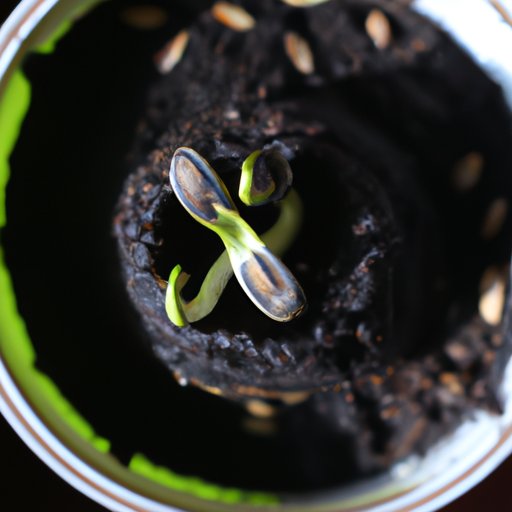Introduction
Starting sunflower seeds indoors can be a rewarding experience, but it requires careful preparation and attention to detail. For those who are new to gardening, the prospect of starting sunflower seeds can be intimidating. However, with some guidance and a few simple steps, anyone can successfully grow sunflowers from seed.
Prepare the Containers
The first step in the process is to choose the right container for your sunflower seeds. It’s best to use shallow containers that are at least six inches deep, as sunflower roots need plenty of room to spread out. If you don’t have shallow containers, you can also use larger ones and fill them with potting soil.
Once you’ve selected your containers, you’ll need to prepare the soil. The best soil for sunflowers should be light and well-draining, so adding compost or peat moss will help ensure that the soil retains enough moisture without becoming waterlogged. You can also add a slow-release fertilizer to give the plants a boost.
Plant the Seeds
When planting sunflower seeds, it’s important to remember that they should be planted at a depth of about one inch and spaced about four inches apart. Once you’ve planted the seeds, cover them with a thin layer of soil and lightly pat down. Make sure to label your containers, so you know which plants are sunflowers and which are something else.
Water and Monitor Moisture Levels
Sunflower seeds need to be kept moist until they germinate, so make sure to check the soil daily and water as needed. How much water you need to give your sunflowers will depend on the size of the container and the type of soil you’re using. It’s also important to monitor moisture levels, as too much or too little water can cause the seeds to fail to germinate.

Give the Sunflowers Adequate Light
Once the sunflower seeds have germinated, they will need plenty of light to thrive. Place the containers near a sunny window or use grow lights to provide the necessary amount of light. For best results, make sure to keep the lights on for at least 12 hours each day.
Fertilize and Prune as Needed
As the sunflowers begin to grow, you may want to add a liquid fertilizer to give them a boost. Additionally, you may need to prune the plants if they become overcrowded or if any of the stems become weak. Pruning will help encourage stronger, healthier growth.

Transplant to a Larger Pot
When the sunflower plants are a few inches tall and have several true leaves, it’s time to transplant them to a larger pot. Choose a pot that is large enough to accommodate the root structure, and fill it with fresh potting soil. Gently remove the plant from its original container and place it in the new pot. Be sure to water the newly transplanted sunflower well.

Harden Off Before Planting Outdoors
Before planting your sunflowers outdoors, you will need to harden them off. This process involves gradually introducing the plants to direct sunlight and other environmental factors. Start by placing the plants in a sheltered area for a few hours each day and gradually increase the amount of time spent in direct sunlight over the course of a week or two. Other hardening steps include reducing the amount of water given to the plants and introducing them to windy conditions.
Conclusion
Starting sunflower seeds indoors is a great way to get a jumpstart on your garden, and it doesn’t have to be difficult. By following these steps—preparing the containers, planting the seeds, monitoring moisture levels, giving the sunflowers adequate light, fertilizing and pruning as needed, transplanting to a larger pot, and hardening off before planting outdoors—you can successfully grow healthy sunflowers from seed.
If you’re looking for more information on starting sunflower seeds indoors, there are plenty of resources available online. Gardeners of all experience levels can benefit from reading up on the basics of sunflower care, as well as more advanced topics such as pest management and disease prevention.
(Note: Is this article not meeting your expectations? Do you have knowledge or insights to share? Unlock new opportunities and expand your reach by joining our authors team. Click Registration to join us and share your expertise with our readers.)
